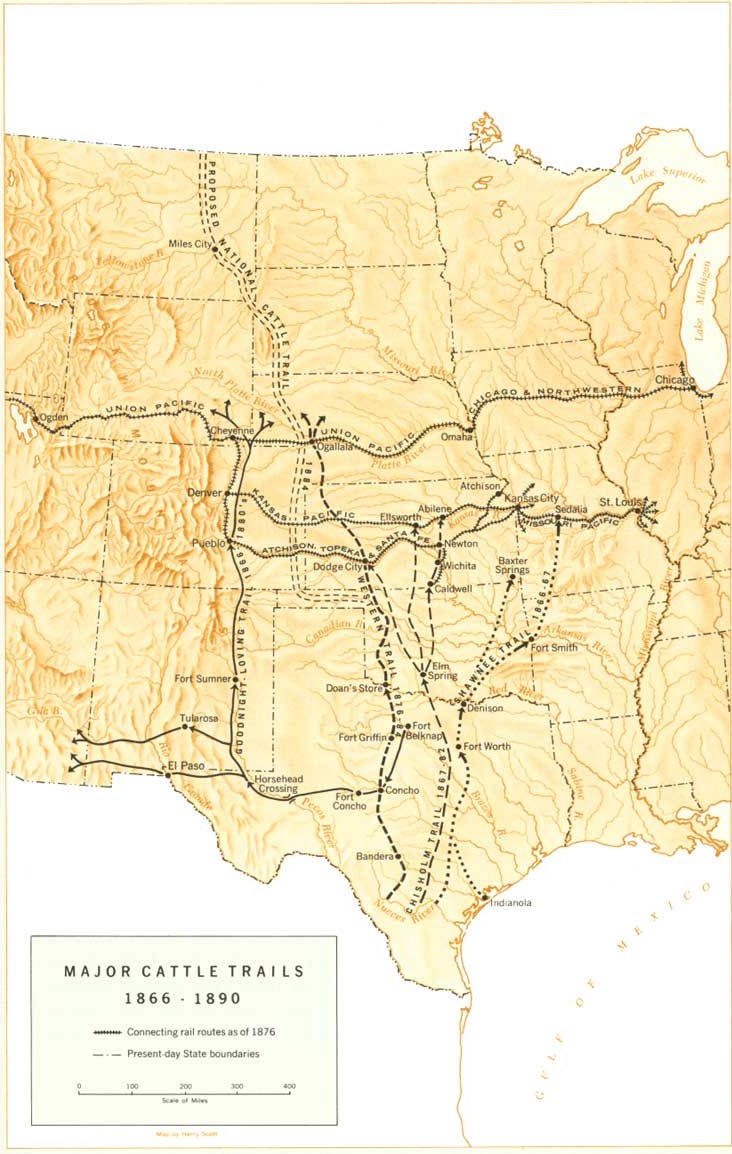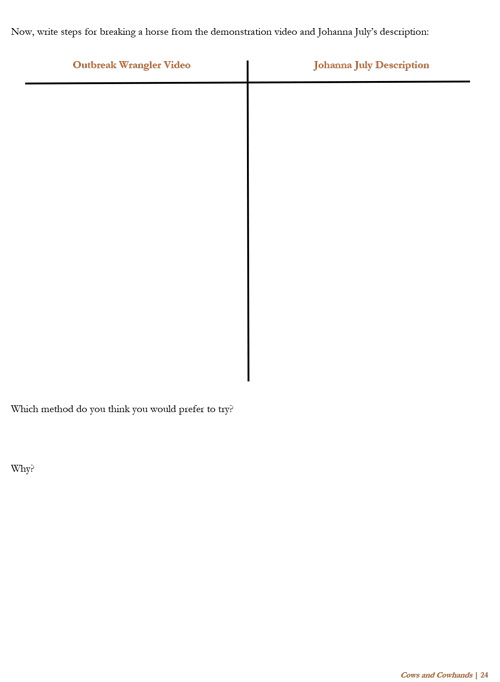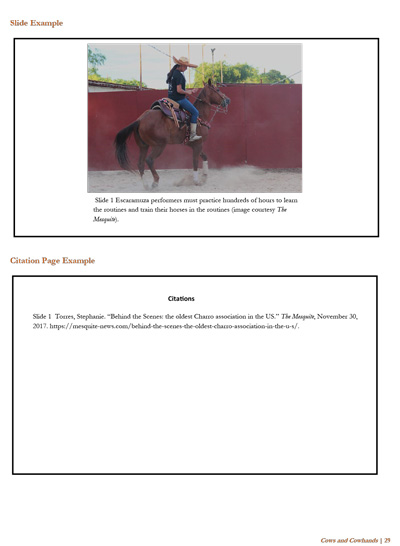
Cows and Cowhands
Activities
Citing Evidence from Multiple Sources: How Do You Break a Horse?
Don’t be alarmed! “Breaking a horse” is a different way of saying, “training a horse.” Believe it or not, horses are not born ready and willing to follow instructions have someone ride on their back. The process of training a horse to be ridden is called “breaking a horse.” Different groups and different cultures have their own preferred method of breaking horses. Watch this current example of how to break a horse:
“Breaking Wild Horses: Outback Wrangler” by Nat Geo Wild
https://www.youtube.com/watch?v=eHwGWBJyMSg
Now, read this account by Johanna July of the method she developed to break a horse. Since people spoke differently during the 1930s, when this interview was conducted, you may have to read it a couple of times:
As a girl, Johanna was not required to do a woman's work about the place. Her meals were always ready for her and her clothes were washed. Her job was to break horses, take them to water, cut grass for them, look after the other stock and ride, ride, ride…
The horses were there to break and Johanna, being dextrous and nimble, was quite able to accomplish the task, though she devised her own means of doing so...
"I could break a hoss myself, me and my Lawd,’ she declared soberly. ‘Many a narrow scrape I've been through wid hosses and mules. I'll tell you how I broke my hosses. I would pull off my clothes and get into de clothes I intended to bathe in and I would lead 'em right into de Rio Grande and keep 'en in dere till dey got pretty well worried. When dey was wild, wild, I would lead 'im down to de river and get 'im out in water where he couldn't stan' up and I would swim up and get 'im by de mane an' ease up on 'im. He couldn't pitch and when I did let 'im out of dat deep water he didn't want to pitch. Sometimes dey wasn't so wore out an' would take a runnin' spree wid me when dey got out in shallow water where dey could get deir feet on de ground, and dey would run clear up into de corral. But I was young and I was havin' a good time."
Angermiller, Florence. Johanna July–Indian Woman Horsebreaker: a machine readable transcription. Texas. Manuscript/Mixed Material. https://www.loc.gov/item/wpalh002207/
Now, write steps for breaking a horse from the demonstration video and Johanna July’s description:
Which method do you think you would prefer to try?
Why?
Using Maps: Measuring Scale and the Cattle Trails
When you look at a map, have you ever wondered what this is?
![]()
How to use the scale and measure distance on a map
The easiest way to measure scale is to take a piece of paper or cardstock and mark the length on the paper. Then, take the paper and measure how many of the sections you marked are from one point to another on a map. If it does not come out even, then you can estimate how much of the section is left and add that number as a decimal. Count the sections and multiply that by the length that section represents.
So, if you used a scale ruler that showed 1 section on the homemade rule equals 300 kilometers
And you measured six and a half sections between one point and another, the actual distance would be:
- Six and a half (6.5) sections x 300 kilometers
- The actual, real-life distance between the two points would be 1,950 kilometers.
Print the map and make a scale ruler from the scale on the map. Measure the distance for the following cattle trails:
- The Shawnee Trail to Sedalia, Missouri
- The Chisholm Trail to Abilene, Texas
- The Goodnight-Loving Trail to Cheyenne, Wyoming
What are the distances you figured? Don’t forget to add the unit of measurement (km or miles)!
The Shawnee Trail to Sedalia is:
The Chisholm Trail to Abilene is:
The Goodnight-Loving Trail to Cheyenne is:
Take it a step further!
Think about how fast cattle can go and about the distance the drovers had to cover. On most days, cattle would move 15 to 20 miles or 24 to 32 kilometers a day. With that information, you can figure out how many days it took to go that distance. All you do is take the speed and divide it into the length of trail. Try it!
How long did it take to move cattle on the Chisholm Trail?

Map courtesy National Park Service
Interpreting Texts: Music Analysis
Using Yampa Valley Boys’ version of “Old Cowboy’s Lament,” listen to and read the lyrics of the song.
“Old Cowboys Lament”
https://www.youtube.com/watch?v=v8BIQZGjDPI
The range’s filled up with farmers and there’s fences ev’rywhere
A painted house ‘most ev’ry quarter mile
They’re raisin’ blooded cattle and plantin’ sorted seed
And puttin’ on a painful lot o’ styleThere hain’t no grass to speak of and the water holes are gone
The wire of the farmer holds ’em tight
There’s little use to law ’em and little use to kick
And mighty sight less use there is to fightThere’s them coughin’ separators and their dirty, dusty crews
And wagons runnin’ over with the grain
With smoke a-driftin’ upward and writin’ on the air
A story that to me is mighty plainThe wolves have left the country and the long-horns are no more
And all the game worth shootin’ at is gone
And it’s time for me to foller, ’cause I’m only in the way
And I’ve got to be a-movin’ — movin’ on.Answer these questions
- Why do you think the song’s name means?
- What do you think was the message of the song?
- How does this song relate to what happened to the idea of the Wild West and cowboys?
- How might writing a song or music in general help people from around the world understand a culture they are unfamiliar with?
Creating Visual Presentations: Escaramuzas in the United States
Escaramuzas are increasingly popular in the United States. They are very memorable to watch because of the difficulty of the movements and the eye-catching costumes. Watch this video to learn about escaramuzas.
“Escaramuza Transcends Borders.” CBS News, December 8, 2021.
https://www.youtube.com/watch?v=_ImqGF37n3w
You have the ability to tell stories in an interesting way. A great way to tell a story is with pictures. The use of pictures or visual elements adds interest and depth to the story you are communicating, but picking the right photograph takes some practice. When selecting a picture, you want to make sure it shows what you are trying to explain to the viewer. If you are trying to explain an action, then you want to make sure your picture shows that action. If you have a lot of pictures in your presentation, make sure you have a variety of subjects rather than the same kind of picture multiple times, like posed portraits of one person.
The most important thing to include when you use material created by someone else is a citation. A citation gives credit to the creator. It can also help your viewer know what source to use to find out who the creator is.
In this activity, you will create a visual presentation using presentation software like PowerPoint, Slides, Canva, or Prezi. You will educate your viewer about escaramuzas. Below are the captions that you can cut and paste into your presentation, but you will need to find pictures that match the captions. When you find a picture, make sure you include the credit. For this presentation, you will add the credit in the “image courtesy” section. On the last page, you will have a list of images, the sites you got them from, and the links. This page is often called a “works cited” or “bibliography” page. They are very important to include because they show that you are not claiming someone else’s work as your own. When people do take credit for other people’s work, this is called plagiarism or academic dishonesty. When you cite something, you want to do your best to find the name of the creator, the title, the website, the date, and the link. Sometimes, you will not find all of that information. If that is the case, do your best. As long as you include a title and the link, the viewer can check out the information on their own; that is the goal of a citation page.
Text for Escaramuza presentation
- Escaramuza is an all-female team competition where the women ride the horses in very precise patterns (image courtesy __________________ ).
- Escaramuza is originally from Mexico (image courtesy __________________ ).
- Escaramuza began at Charreadas, or rodeos, in Mexico about 70 years ago (image courtesy __________________ ).
- The performers ride their horse side saddle (image courtesy __________________ ).
- Some people call escaramuza “ballet with horses” (image courtesy __________________ ).
- The escaramuza costume is very specific and elaborate (image courtesy __________________ ).
- For many performers in the US, escaramuza is a way to celebrate their Mexican heritage (image courtesy __________________ ).
- Competitive escaramuza began in the US in 1991 (image courtesy __________________ ).
- Escaramuza is becoming more popular in the US (image courtesy __________________ ).



